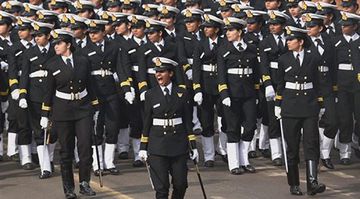Indian Women And The Armed Forces
I have lived with the uniform all around me for twelve years of my life, having married one of them. The sharp creases and shining boots are proudly worn filling the onlooker with awe. It is an awe for the life behind the ostensible glamour of the uniform - a life that is honed and made battle hardy by years of rigorous discipline. Standing amongst them with berets and epaulettes announcing their ranks, are women in uniform.
Historically, we have been told of women who have led troops when enemy knocked at the door. However, these daring women remained in the romanticized niche as isolated incidents. Times changed and so did women’s aspirations. Women in uniform have already been serving in the Army Dental Corps, Army Medical Corps and the Military Nursing Services. While the Indian armed forces dilly dallied and finally inducted women in short service commission in 1992, the women set their eyes on areas that had sealed their doors to them. For there were none yet in fighting arms.
Things are set to change. Flying Cadets Avani Chaturvedi, Bhawana Kanth, Mohana Singh are on the brink of history, a couple of months short of being the first Indian women fighter pilots to be inducted into the IAF. Their path has been paved by the many others who made their foray into the Indian armed forces like Air Marshal Padmavathy Bandopadhya, Lt Gen Punita Arora, Flight Officer Gunjan Saxena, first woman recipient of Shaurya Vir, Lt Col Mitali Madhumita, the first woman army officer with a gallantry award, Sena Medal.
So what drives these women to set aside comfortable lifestyles and jump into a career that sees unpredictable shifts in their surrounding environment?
- For many of them, it is the call of the nation.
- For others , it is the natural transition into the uniform following in the footsteps of their uniformed male family members.
- A growing breed is the one responding to their instinct for a challenging life.
- When they take the plunge they are fully aware of the hardships and reconcile to erratic lifestyles and family life. But eventually they do work out a pattern that gives them the best in the given situations, in terms of family time and commitments.
However, the issue is not simply a matter of breaking glass ceilings, as pointed out by some defense experts. It pertains to a larger picture of national defense, given India’s shared boundaries with hostile neighbours. Indian troops are stationed at the borders and the militant infested zones throughout the year that takes a toll on a soldier’s physical and psychological fitness despite rigorous training.
Within the troops, there are dynamics at work that may resent women not allowed for night duties, patrolling, and being in the frontline. To maintain the cohesive nature of the troops and avoid expensive errors of judgment at the cost of national security, many such issues will have to be addressed before the plunge is taken.
Till then, with one rung at a time, Indian women are spreading out in the Indian armed forces. So when they see the challenging one liner “do you have it in you?”, they are all out to prove that adventure and adaptation are not gender specific.
By Ilakshee Nath
















